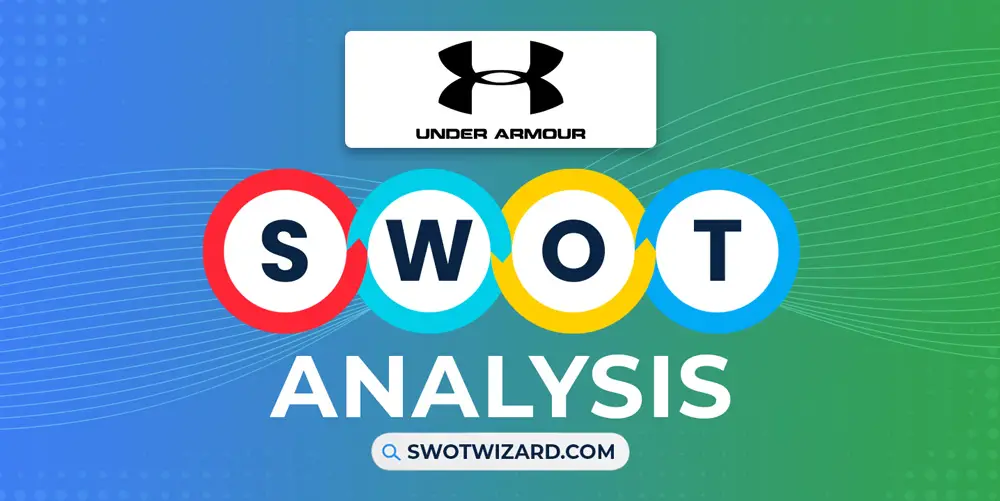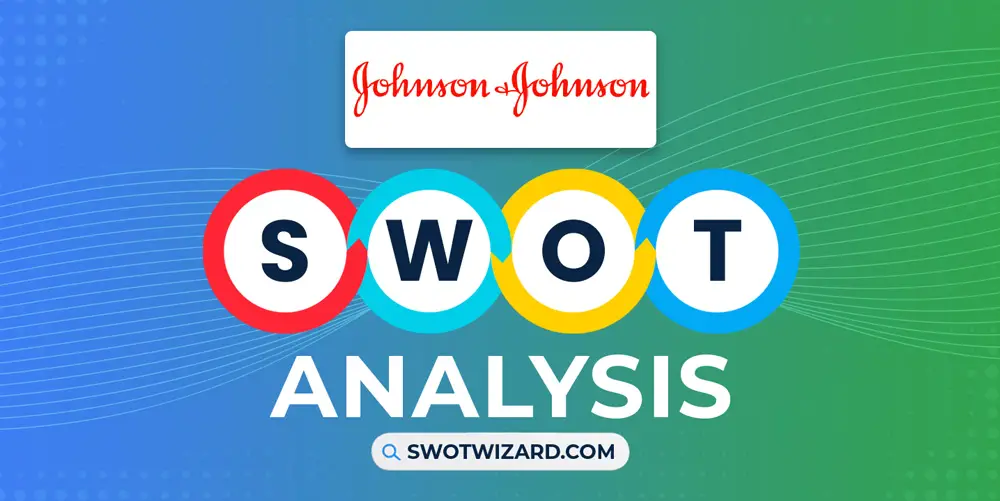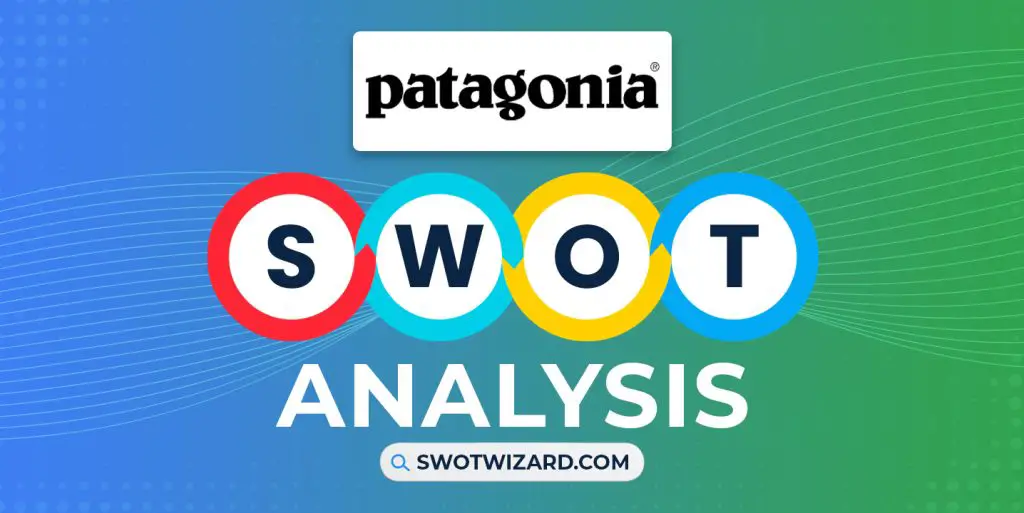Although Under Armour is an established brand in the profitable sports gear market, it is far behind its competitors. Currently, it has a low market cap of $4.04 billion only, making it the world’s 2740th company. To understand how companies fail even in powerful markets, let’s examine Under Armour SWOT analysis.
Under Armour: Company Overview
| Company | Under Armour, Inc. |
| Industry | Textile, sports equipment |
| Founded | 1996 |
| Founder | Kevin Plank |
| President & CEO | Colin Browne |
| Headquarter | Baltimore, Maryland, U.S. |
| No. of Employees | 17,500+ |
| Annual Revenue | $5.683 (FY 2021) |
| Website | underarmour.com |
Under Armour was founded in 1996 by Kevin Plank, who wanted to create better, practical sports gear for athletes. The idea was very profitable, as the company made $17,000 that very year, increasing to $3 billion by 2014. Under Armour claimed its market share by exclusively targeting professional athletes and teams for marketing, netting sales from NFL’s Frank Wycheck and Deion Sanders and then the teams Georgia Tech and North Carolina State.
Now, the company is a US-based sports gear brand with headquarters in Baltimore, Maryland. In 2022, its TTM revenue increased to only $5.80 billion, compared to hundreds of billions of more powerful brands such as Nike.
Product & Services of Under Armour
Athletic shoes | T-shirts | Jackets | Hoodies | Pants | Leggings | Shorts | Athletic bras | Athletic bags | Face Masks | Gloves | Caps and Protective gear
Under Armour Competitors
Adidas | Nike | Puma | Skechers | Fila | New Balance | Lululemon | ASICS | Hanesbrands | VF
Did You Know?
Under Armour’ came from founder Kevin Plank’s frustration with cotton undervests, which would become soggy, grimy, and get bunched up in the field. He sought to solve this issue with a better fabric and created the company as a result.
Strengths – Under Armour SWOT Analysis
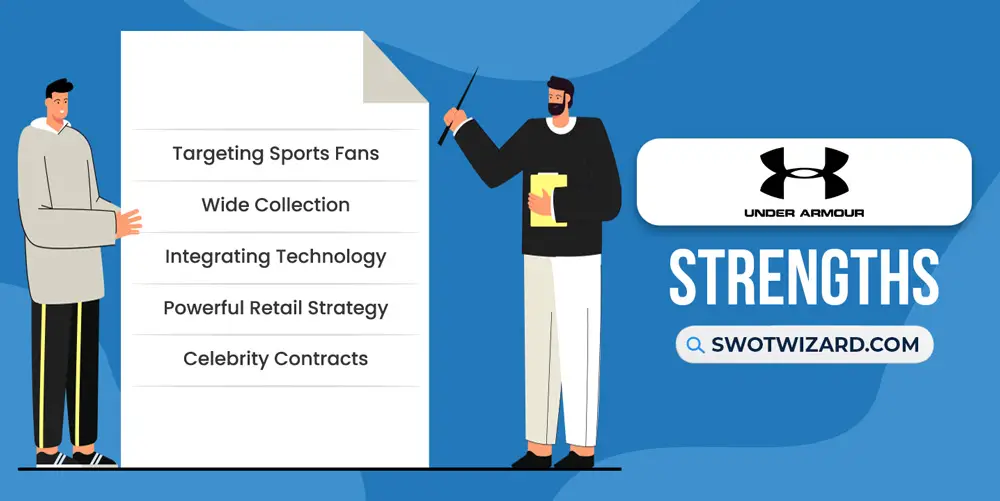
Targeting Sports Fans: Under Armour’s target demographic is sports fans, specifically basketball and American football fans. Globally, over 450 million people play basketball, and 70,000 of them play on a professional level. And NBA’s most avid fans are within the age range of 18-44. These customers are active, prefer quality goods, wear down apparel the fastest, and are the biggest spenders in terms of both amount and frequency.
Wide Collection: Under Armour offers a large collection of sportswear to its customers. Only for men, Under Armour offers the subcategories baselayer, jackets and vests, pants and leggings, shirts and tops, shoes, shorts, swimwear, and underwear, with a total of 2062 unique options to pick from. For women, it offers the previous 7 sub categories with sports bras, totaling a staggering 1842 options to choose from. Even for children, the brand has over 1247 items, making its collection truly monolithic.
Integrating Technology: Under Armour expends a lot of effort into creating pragmatic solutions for issues its users may experience. The brand’s UA Rush claims to be a built-in infrared mechanism that increases users’ energy and endurance and lowers their muscle fatigue. UA Smartform uses a unique auxetic structure to take the exact shape of the user’s body, ISO-chill absorbs UV and traps body heat effectively to keep the users warm, and Coldegear is breathable apparel that claims to help vent body heat easier.
Powerful Retail Strategy: Under Armour has created a retail strategy that utilizes 3rd parties and physical and virtual sales channels to great effect. The brand has 164 locations in the US, and over 435 brand and factory houses across the world, along with a website to sell its products. However, over 57% of its sales come from wholesale or by selling its products to 3rd parties, and 2% of the sales come from licensed vendors and manufacturers. This strategy ensures high market saturation, which allowed Under Armour to sell $1264.13 million worth of footwear in 2021.
Celebrity Contracts: Under Armour secures a large portion of its customer base by securing contracts with athletes. Under Armour has formed contracts with Tom Brady, Stephen Curry, Joel Embiid, Julio Jones, Cam Newton, Brandon Marshall, and many more celebrity athletes from the NBA and NFL. Stephen Curry, in particular, turned out to be Under Armor’s most profitable addition, as the Curry lineup caused a 30% surge in sales in 2016. The brand also launched Project Rock with Dwayne Johnson in 2016, which let it access the celebrity ex-wrestlers wide fan group.
Weaknesses – Under Armour SWOT Analysis

Dependent On North American Sales: Under Armour is heavily reliant on its North American sales for generating revenue. From 2015 to 2021, the brand consistently sold the highest in that region and, as a result, has doubled down on increasing sales in North America. Unfortunately, this decision has slowed down the company’s growth and reach, as even in 2021, the brand generated $3810.37 million worth of revenue from North America, and its second-highest generator was EMCA, with only $842.51 million. This focus on a single region will not yield any higher revenue when the market becomes fully saturated with the brand.
Limited International Presence: Under Armour is a popular brand in the US, but not so much across international markets. Across 100 countries, the brand has over 435 retail outlets, which is very little considering Under Armour has been in operation for 26 years. While international revenues saw a large increase up to 2017, Under Armour lack of marketing in the international space, brand value, and heavy usage of 3rd parties for sales have kept its international revenue from contributing a significant percentage to its TTM revenue.
Stronger Competitors: Under Armour may be an old business in the sportswear industry, but it is far from the most powerful. Nike is one of its largest competitors, with a market cap of over $183.78 billion in 2022 and more than 79,100 employees. Another powerful competitor is Adidas, with a market cap of over $27.83 billion and over 59,533 employees in 2022. Aside from these, Puma, Skechers, and New Balance are notable competitors, with a market cap similar to or greater than Under Armour.
Dependent On Celebrity Deals: While Under Armour’s celebrity and star athlete deals to boost its sales, overreliance on these undermines the brand’s impact. So long as Under Armour’s contracted athletes perform well and remain in the spotlight, Under Armour can sell its featured collections. However, when they underperform or face scrutiny, Under Armour’s sales go down, and the brand’s image is threatened. Mo Bamba signed a deal with the company at the start of his career, but he has been removed from the spotlight, and it impacted the brand’s sales negatively.
Opportunities – Under Armour SWOT Analysis
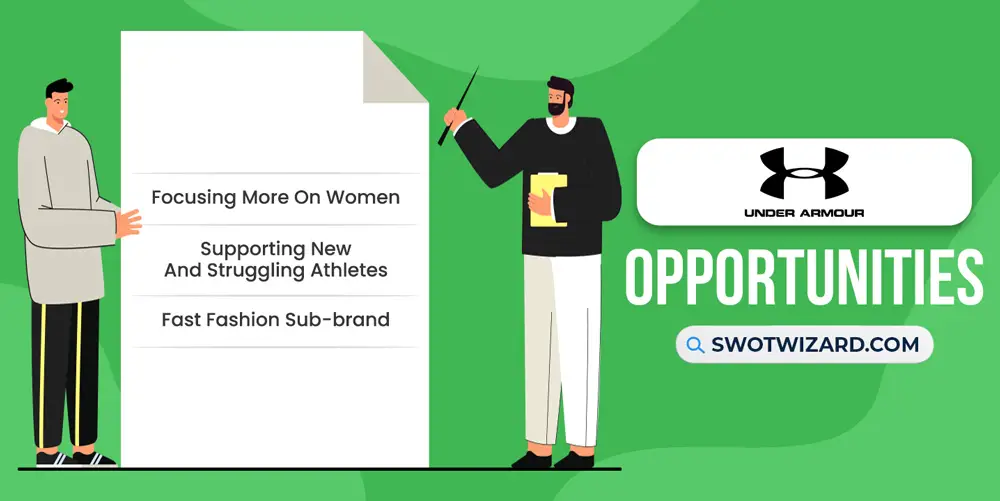
Focusing More On Women: Under Armour is currently one of the few brands focusing on women’s sporting goods, especially with its breathable M+MI clothing and HOVR Breakthru basketball shoe lines. Online sales for women’s activewear saw an increase of 77% in 2020, even with the pandemic raging. Even after featuring female athletes, famous sports brands can claim such popularity and sales increase. Under Armour can invest in women’s sports gear even more and completely dominate this niche before other companies gain a larger market share.
Supporting New And Struggling Athletes: Under Armour can invest its marketing cost in charity and supporting upcoming athletes. By presenting a supportive image to new and struggling athletes, the brand can enhance its reputation. Under Armour spent $649.2 million in marketing in 2021, so it can afford to spend a couple hundred million on this effort.
Fast Fashion Sub-brand: Under Armour can create a sub-brand that creates sports-themed fashion apparel, which is of lower quality with a moderate markup. This sub-brand will focus on replicating its designs and producing inferior but affordable versions. The company can reel in some extra revenue as many customers like the sports gear aesthetic but don’t want to fork out the cash for it.
Threats – Under Armour SWOT Analysis
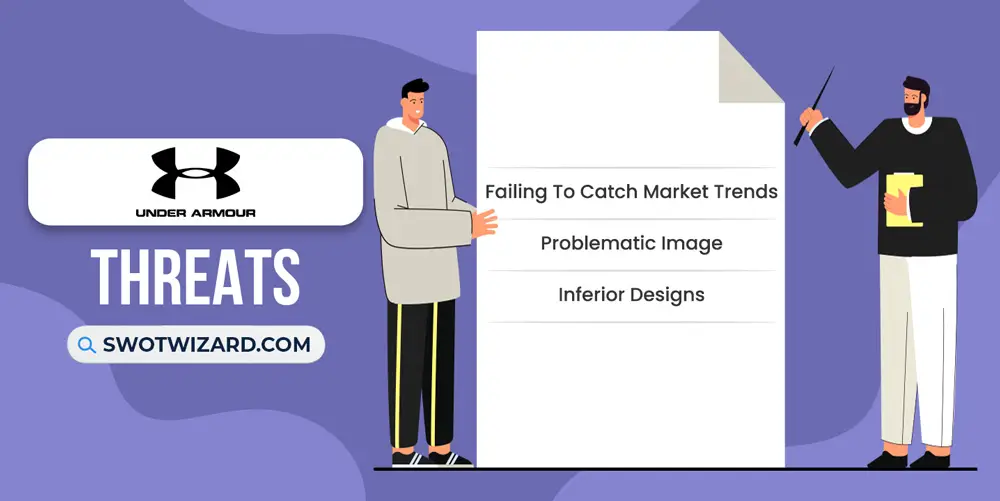
Failing To Catch Market Trends: Under Armour has been failing to catch and exploit market trends for a while. While other brands are aggressively marketing the recycling processes, carbon neutrality percentages, and sustainability, Under Armour does not emphasize or elaborate on these aspects. If it continues to fail in marketing its accountability and environmental friendliness, it will turn conscious customers away from the brand.
Problematic Image: Under Armour has become a problematic investment for shareholders, as many financial expenses and records are withheld from them. The company had to pay $9 million to investors in a lawsuit for using the “pull forward” strategy and misleading them. To this day, it cannot account for the cash that its employee activities and founder’s expenses use up, which has decimated trust and threatened the company’s existence.
Inferior Designs: Under Armour have failed to create any designs that stand out against its competitors. Unlike Nike’s SB Dunk Low “Raygun”, “Heaven’s Gate”, Air Force 1, or Adidas’ Stan Smith, Samba, and 4DFWD 2, Under Armour can offer nothing equally as iconic. Lacking unique designs can make the brand fade into mediocrity.
[Bonus Infographic] SWOT Analysis of Under Armour
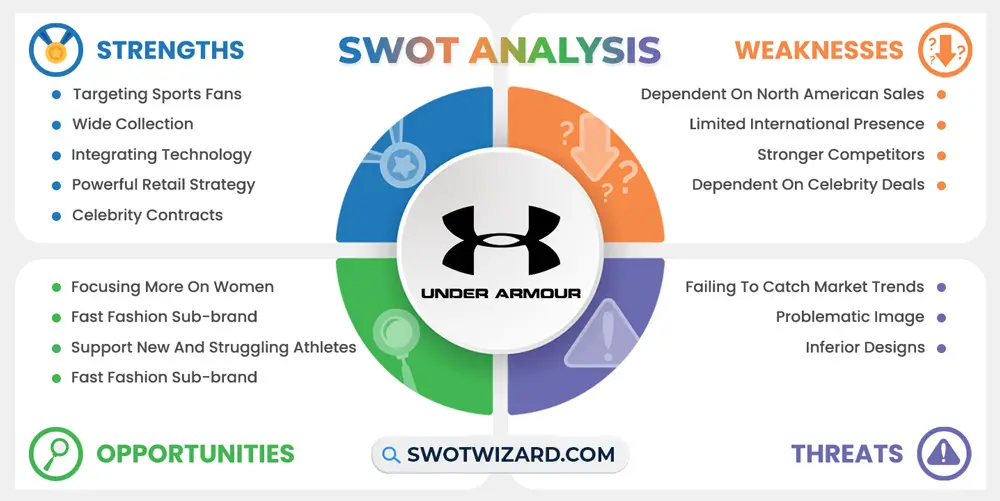
Recommendations for Under Armour
To catch up with its strongest competitors, Under Armour can consider these strategies.
- Under Armour can use community feedback to create iconic designs.
- The company can launch ghost labels to sustain itself.
- It can sign contracts with e-sports professionals.
- It should market its sustainability and carbon offset more aggressively.
- The company should become more accountable to its shareholders.
Frequently Asked Questions (FAQs)
What is Under Armour’s slogan?
The brand’s slogan is, “Under Armour athletes are tough. Ready to take on a challenge.”
Who is the brand ambassador for Under Armour?
Under Armour’s brand ambassador is currently Kevin Alexander.
Final Words on Under Armour SWOT Analysis
Under Armour has failed as a sports gear company due to internal management failures, accountability issues, lacking uniqueness, and failure to create an image. To sustain itself, the brand has to play to its strengths. If it focuses more on women’s apparel, creates unique designs, and promotes its sustainability, it can eventually hope to catch up to Nike and Adidas.
References
- Wikipedia contributors. (n.d.). Under Armour, Inc. Wikipedia.
- Baer, D. (2015, February 19). Here’s how Under Armour grew into a $15 billion athletic-apparel empire. Business Insider.
- Adidas (ADS.DE) – Market capitalization. (n.d.). CompaniesMarketCap.
- Creswell, J., & Draper, K. (2020, January 27). How Under Armour lost its edge. Chicago Tribune.
- Debter, L. (2016, April 21). Under Armour Sales Jump 30% As Stephen Curry Shoes Prove A Slam Dunk. Forbes.
- Faria, J. (2023, January 6). Under Armour: marketing spending 2021. Statista.
- Feuer, W. (2021, May 4). Under Armour pays SEC $9 million for allegedly misleading investors. New York Post.
- Flammia, C. (2022, December 2). The 11 Best adidas Sneakers of 2022. Footwear News.
- Foster, A. C. (2015, December). Consumer expenditures vary by age. U.S. Bureau of Labor Statistics.
- GORSLER, F. (n.d.). THE 50 MOST INFLUENTIAL NIKE DUNKS IN HISTORY. HIGHSNOBIETY.
- Harris, Z. (n.d.). Ten most famous Under Armour athletes. Franchise Sports.
- How Many Fans Does Basketball Have? | Hoops Addict. (2022, May 24). Hoops Addict.
- LoRé, M. (2020, September 15). Under Armour’s Focus On Women Is Paying Dividends In Innovation And Sales. Forbes.
- McCarthy, M. (2016, January 16). Dwayne “The Rock” Johnson signs endorsement deal with Under Armour. The Sporting News.
- Number of Under Armour locations in United States. (2023, February 9). ScrapeHero.
- Team, T. (2017, December 1). A Look At Under Armour’s International Presence. Forbes.
- Our Company. (n.d.). Under Armour.
- UA Technology. (n.d.). Under Armour.

